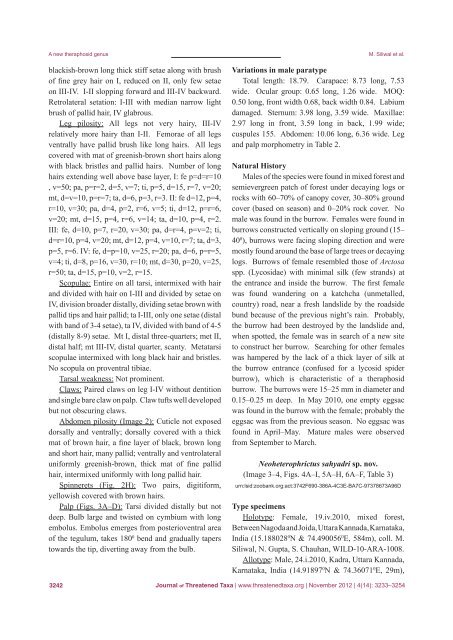View - Journal of Threatened Taxa
View - Journal of Threatened Taxa
View - Journal of Threatened Taxa
Create successful ePaper yourself
Turn your PDF publications into a flip-book with our unique Google optimized e-Paper software.
A new theraphosid genusblackish-brown long thick stiff setae along with brush<strong>of</strong> fine grey hair on I, reduced on II, only few setaeon III-IV. I-II slopping forward and III-IV backward.Retrolateral setation: I-III with median narrow lightbrush <strong>of</strong> pallid hair, IV glabrous.Leg pilosity: All legs not very hairy, III-IVrelatively more hairy than I-II. Femorae <strong>of</strong> all legsventrally have pallid brush like long hairs. All legscovered with mat <strong>of</strong> greenish-brown short hairs alongwith black bristles and pallid hairs. Number <strong>of</strong> longhairs extending well above base layer, I: fe p=d=r=10, v=50; pa, p=r=2, d=5, v=7; ti, p=5, d=15, r=7, v=20;mt, d=v=10, p=r=7; ta, d=6, p=3, r=3. II: fe d=12, p=4,r=10, v=30; pa, d=4, p=2, r=6, v=5; ti, d=12, p=r=6,v=20; mt, d=15, p=4, r=6, v=14; ta, d=10, p=4, r=2.III: fe, d=10, p=7, r=20, v=30; pa, d=r=4, p=v=2; ti,d=r=10, p=4, v=20; mt, d=12, p=4, v=10, r=7; ta, d=3,p=5, r=6. IV: fe, d=p=10, v=25, r=20; pa, d=6, p=r=5,v=4; ti, d=8, p=16, v=30, r=10; mt, d=30, p=20, v=25,r=50; ta, d=15, p=10, v=2, r=15.Scopulae: Entire on all tarsi, intermixed with hairand divided with hair on I-III and divided by setae onIV, division broader distally, dividing setae brown withpallid tips and hair pallid; ta I-III, only one setae (distalwith band <strong>of</strong> 3-4 setae), ta IV, divided with band <strong>of</strong> 4-5(distally 8-9) setae. Mt I, distal three-quarters; met II,distal half; mt III-IV, distal quarter, scanty. Metatarsiscopulae intermixed with long black hair and bristles.No scopula on proventral tibiae.Tarsal weakness: Not prominent.Claws: Paired claws on leg I-IV without dentitionand single bare claw on palp. Claw tufts well developedbut not obscuring claws.Abdomen pilosity (Image 2): Cuticle not exposeddorsally and ventrally; dorsally covered with a thickmat <strong>of</strong> brown hair, a fine layer <strong>of</strong> black, brown longand short hair, many pallid; ventrally and ventrolateraluniformly greenish-brown, thick mat <strong>of</strong> fine pallidhair, intermixed uniformly with long pallid hair.Spinnerets (Fig. 2H): Two pairs, digitiform,yellowish covered with brown hairs.Palp (Figs. 3A–D): Tarsi divided distally but notdeep. Bulb large and twisted on cymbium with longembolus. Embolus emerges from posterioventral area<strong>of</strong> the tegulum, takes 180 0 bend and gradually taperstowards the tip, diverting away from the bulb.M. Siliwal et al.Variations in male paratypeTotal length: 18.79. Carapace: 8.73 long, 7.53wide. Ocular group: 0.65 long, 1.26 wide. MOQ:0.50 long, front width 0.68, back width 0.84. Labiumdamaged. Sternum: 3.98 long, 3.59 wide. Maxillae:2.97 long in front, 3.59 long in back, 1.99 wide;cuspules 155. Abdomen: 10.06 long, 6.36 wide. Legand palp morphometry in Table 2.Natural HistoryMales <strong>of</strong> the species were found in mixed forest andsemievergreen patch <strong>of</strong> forest under decaying logs orrocks with 60–70% <strong>of</strong> canopy cover, 30–80% groundcover (based on season) and 0–20% rock cover. Nomale was found in the burrow. Females were found inburrows constructed vertically on sloping ground (15–40 0 ), burrows were facing sloping direction and weremostly found around the base <strong>of</strong> large trees or decayinglogs. Burrows <strong>of</strong> female resembled those <strong>of</strong> Arctosaspp. (Lycosidae) with minimal silk (few strands) atthe entrance and inside the burrow. The first femalewas found wandering on a katchcha (unmetalled,country) road, near a fresh landslide by the roadsidebund because <strong>of</strong> the previous night’s rain. Probably,the burrow had been destroyed by the landslide and,when spotted, the female was in search <strong>of</strong> a new siteto construct her burrow. Searching for other femaleswas hampered by the lack <strong>of</strong> a thick layer <strong>of</strong> silk atthe burrow entrance (confused for a lycosid spiderburrow), which is characteristic <strong>of</strong> a theraphosidburrow. The burrows were 15–25 mm in diameter and0.15–0.25 m deep. In May 2010, one empty eggsacwas found in the burrow with the female; probably theeggsac was from the previous season. No eggsac wasfound in April–May. Mature males were observedfrom September to March.Neoheterophrictus sahyadri sp. nov.(Image 3–4, Figs. 4A–I, 5A–H, 6A–F, Table 3)urn:lsid:zoobank.org:act:3742F690-386A-4C3E-BA7C-97378673A96DType specimensHolotype: Female, 19.iv.2010, mixed forest,Between Nagoda and Joida, Uttara Kannada, Karnataka,India (15.188028 0 N & 74.490056 0 E, 584m), coll. M.Siliwal, N. Gupta, S. Chauhan, WILD-10-ARA-1008.Allotype: Male, 24.i.2010, Kadra, Uttara Kannada,Karnataka, India (14.91897 0 N & 74.36071 0 E, 29m),3242<strong>Journal</strong> <strong>of</strong> <strong>Threatened</strong> <strong>Taxa</strong> | www.threatenedtaxa.org | November 2012 | 4(14): 3233–3254

















